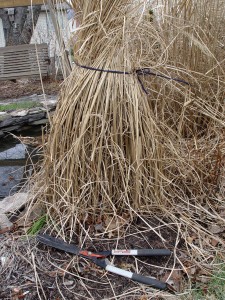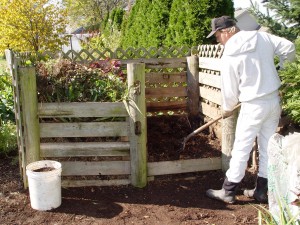Triage in the Garden
April 3rd, 2008
It’s crunch time for the non-obsessed gardener.
That would be the folks who get around to most of their yard work over two weekends in spring as opposed to the ones out there every day in February brushing away snow to check for the first crocus shoots.
You know who you are.
For the non-obsessed, April isn’t a pretty prospect.
There’s so much to do and so little time.
Rather than reach for the Xanax or Red Bull, consider triage.
Triage is a battlefield and emergency-room term that describes how to prioritize care when you’ve got way more wounded than healers.
The idea is to treat patients who need immediate life-saving care first while dealing with the non-life-threatening cases later.
In the yard, triaging can make that giant to-do list less imposing by separating the “must-do’s” from the “can-waits.”
First, ratchet down the pressure. If you don’t get to everything, that’s OK. Whether your lawn gets fertilized or not isn’t a life-or-death matter.
Don’t drive yourself to the point of exhaustion. And don’t work so hard that you forget to enjoy the fresh air, the free exercise, the beauty you’re creating and the health you have to be out there in the first place.
You can always play catch-up later and in the meantime tell people you’re experimenting with a new prairie-style informal design.
They’ll believe it.
Next, triage the to-do list into three parts: 1.) Things you really have to do right now; 2.) Things you can put off until a little later, and 3.) Things you can do a lot later or even in the off-season.
One of the things experienced gardeners learn is that it’s much better to spread a lot of little jobs over a long period than to try to do it all at once.
The quicker you figure that out, the faster your back will stop trying to drive that point home.
The new norm of no winter-long snow cover has helped with that.
Not only has it been possible to break off a lot of spring jobs into fall, we’ve been able to get things done during pockets of previously gardening-dead January and February.
In my yard, for example, I’ve been able to get a big chunk of pruning, branch-chipping, lawn-cleanup and bed-edging work done in both of these past two winters.
But let’s say you blew that opportunity. Again.
Look at what’s staring you in the face, then prioritize.
You might have a couple of big butterfly bushes that you know will get ridiculously huge by fall if you don’t whack them back now.
Or you might have leaves and assorted debris all over the lawn that will smother the grass blades if you don’t rake ASAP.
Or you might still have browned-out ornamental grasses that need to be decapitated before new growth starts to intermingle, making the job much tougher.
Or you might have annual crabgrass problems in the lawn and know that now’s the prime window to put down a crabgrass preventer.
On the other hand, it won’t hurt to put off the hedge-trimming a few weeks.
It won’t hurt to worry about mulching until next month, which actually is a better time anyway after the soil has warmed a bit more.
Neither is it critical to fertilize the garden beds or cut sharp new bed edges now.
And don’t even think about cutting off any green bulb foliage after the blooms are done. At least wait until the leaves yellow to remove them or you’ll risk weakening future flowering.
You may realize you can even put off some work until much later.
Early fall is a great time to plant or transplant trees, shrubs and evergreens if you don’t get to it now.
Most shrubs can be thinned out or selectively cut back throughout summer.
And jobs such as cleaning the tools, sharpening blades, restocking garden supplies and building plant cages or other gizmos can be relegated to winter.
The location of the would-be job also can be decider.
If you’ve got shrubs that need to be pruned in both the front and back yards, deal with the front ones for now and get to the back ones when time permits.
Best of all are jobs you can skip altogether.
There are a few.
The biggest is raking leaves out of garden beds. Don’t think you have to get every last leaf out of the beds at winter’s end.
You can mulch right over top of a thin layer of leaves. That not only saves work, but the leaves break down to add organic matter to the soil while helping to control weeds.
The only leaves that should be removed are those in danger of matting down evergreen groundcovers or those that are so plentiful that they threaten to rot woody-plant bark or prevent perennials from poking up.
Liming lawns is another automatic job that can be counter-productive. Don’t add lime without knowing the soil really needs it.
Ditto with mulch. If you’ve already got a 2- to 3-inch layer, let it ride. Cultivate it if you want, but don’t keep piling it up faster than it’s decaying underneath.
Finally, don’t make jobs harder than necessary.
Most perennials that have browned out over winter (coralbells, hardy geraniums, leadwort, etc.) can be weed-whacked and raked. Short grasses and grass-like perennials such as liriope can be run over with a lawn mower.
That’s easier and quicker than getting down to cut each plant with hand-pruners.
Just ask your back.
Things you really ought to do now (early April) in the yard:
* Rake the lawn, keep it cut regularly and put down your crabgrass preventer or new seed.
* Cut back late-blooming shrubs such as butterfly bush, rose-of-sharon, caryopteris, beautyberry and summersweet.
* Cut back browned-out ornamental grasses and perennials before new growth begins.
* Prune roses.
* Get cool-season vegetables planted, such as broccoli, cabbage, cauliflower, lettuce, spinach, carrots and radishes.
* Get rid of weeds before they spread or go to seed.
* Determine if you’re going to apply any systemic pesticides, such as Merit (imidacloprid) to prevent woolly adelgids on hemlocks or disease controls to head off recurrent problems such as black spot on roses or anthracnose on dogwood.
Things you can put off until a little later:
* Edge the beds.
* Mulch the beds.
* Cut back bulb foliage (wait at least until it yellows).
* Trim the hedges.
* Prune the spring-blooming shrubs, such as lilacs, azaleas, rhododendrons, weigelas, forsythia (wait until right after they’re done blooming).
* Fertilize the garden beds.
Things you can put off until much later or the off-season:
* Improve soil in existing beds.
* Dig new beds.
* Plant or transplant new trees, shrubs, evergreens and perennials (fall is excellent).
* Divide perennial flowers.
* Chip prunings.
* Start compost pile or empty existing ones.
* Revamp the garden you really don’t like.
* Build new walls, paths and garden structures.
* Clean garden tools.
* Sharpen dull mower and tool blades now, but put this on the future off-season list.
* Ditto for garden supplies… catch up now, but in the future, inventory and restock in the off-season.
Three good books to help strategize saner yard care:
* “Tending Your Garden” by Gordon and Mary Hayward (W.W. Norton and Co., $39.95 hardcover, 2007)
* “The Essential Garden Maintenance Workbook” by Rosemary Alexander (Timber Press, $34.95 paperback, 2006)
* “The Well-Tended Perennial Garden” by Tracy DiSabato-Aust (Timber Press, $34.95 hardcover, 2006)










